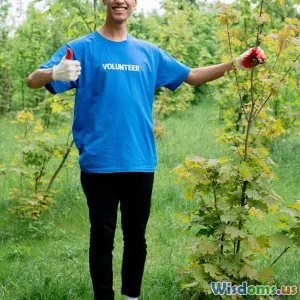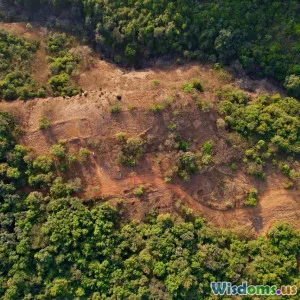
Community Efforts in Conservation
8 min read Explore how communities worldwide are driving conservation efforts to protect nature and promote sustainability. (0 Reviews)
Community Efforts in Conservation: Driving Sustainability
Introduction: The Power of Collective Action in Conservation
In an age of unprecedented environmental challenges, the traditional picture of conservation as the work of isolated experts or government bodies has dramatically changed. Today, community efforts in conservation emerge as a bedrock for sustainable environmental stewardship. But what makes these collective movements so indispensable? And how do local actions weave a broader tapestry of global sustainability?
Understanding the significance of community involvement is crucial. Communities are custodians of land, culture, and biodiversity. Their intimate knowledge, coupled with a vested interest in preserving their local environment, catalyzes impactful and enduring conservation outcomes. Whether it’s restoring native habitats, protecting endangered species, or managing natural resources sustainably, community-led initiatives bring passion, innovation, and resilience to conservation.
This article delves deep into the multifaceted ways communities contribute to conservation efforts globally. We will explore successful models, challenges faced, and inspire action by spotlighting real-world examples and research insights.
What Defines Community Conservation?
Community conservation encompasses organized actions by local groups, indigenous peoples, or residents committed to preserving and sustainably managing natural resources in their area. It often involves:
- Collaborative stewardship: Shared responsibility between community members and sometimes local governments or NGOs.
- Traditional knowledge integration: Utilizing indigenous ecological wisdom passed through generations.
- Sustainability focus: Balancing human needs with ecosystem health to ensure long-term viability.
This grassroots approach contrasts with top-down policies by emphasizing participatory decision-making and tailoring conservation tactics to local socio-cultural contexts.
Why Community Conservation Matters
1. Local Empowerment Yields Effective Management
Studies consistently show that when communities are involved in shaping conservation policies, outcomes improve markedly. The Food and Agriculture Organization (FAO) reports that over 60% of protected forests globally are managed by indigenous groups and local communities, which often results in better protection compared to state-run parks.
For example, in Namibia, the communal conservancy program empowers local communities with rights over land and wildlife management. This initiative has increased wildlife populations by over 20% and created sustainable income through eco-tourism.
2. Preservation of Biodiversity Hotspots
Many biodiversity-rich regions overlap with traditional habitats occupied by indigenous peoples. Community enforcement of conservation rules prohibits destructive practices like illegal logging or poaching.
In the Peruvian Amazon, community-led monitoring using mobile technology has curtailed illegal mining activities that threaten the fragile rainforest ecosystem.
3. Socioeconomic Benefits Drive Sustainability
Conservation efforts that incorporate economic incentives, such as sustainable agriculture, non-timber forest product harvesting, or eco-tourism, provide livelihoods that reduce dependence on environmentally harmful activities.
The example of Bhutan’s community forest program illustrates this synergy, where local communities manage forests for timber, firewood, and medicinal plants, enhancing both conservation and social well-being.
Examples of Successful Community Conservation Initiatives
Community Forest Management (CFM) in Nepal
Nepal pioneered community forest management by transferring government forest lands to local user groups. This policy enabled villagers to make decisions about resource use, protection, and revenue sharing. From 1990 to 2015, forest cover increased by approximately 40%, reversing deforestation trends while improving rural incomes.
Marine Protected Areas in Fiji
Fijian communities implemented Locally Managed Marine Areas (LMMAs) to address overfishing and coral reef degradation. These areas combine traditional closures and scientific monitoring to regulate fishing. Coral reefs within LMMAs have shown significant recovery over a decade, with fish biomass increasing by up to 60%.
The Green Belt Movement in Kenya
Founded by Nobel laureate Wangari Maathai, the Green Belt Movement mobilized thousands of women to plant over 50 million trees. This initiative revitalized degraded land, improved soil health, and empowered women economically and socially while raising environmental awareness nationwide.
Challenges Faced by Community Conservation
While the benefits are clear, community conservation initiatives confront several obstacles:
- Resource conflicts: Disputes over land rights or resource access can undermine trust and cooperation.
- Capacity constraints: Limited technical knowledge, funding, and governmental support hinder sustained management.
- Climate change impacts: Altered weather patterns and species migration complicate conservation strategies.
For instance, in parts of the Amazon, illegal logging and mining continue to threaten indigenous territories despite community efforts due to weak law enforcement and economic pressures.
Strategies for Enhancing Community Conservation Impact
- Policy Integration: Governments should recognize and formalize community rights, embedding them in national conservation plans.
- Capacity Building: Providing training, technology (like drones or GIS mapping), and financial resources empowers communities to monitor and manage effectively.
- Collaborative Networks: Linking community groups with NGOs, scientists, and policymakers fosters knowledge exchange and consolidates efforts.
- Inclusive Participation: Ensuring marginalized groups, including women and youth, have a voice strengthens legitimacy and sustainability.
Conclusion: Inspiring a Movement from the Ground Up
Community efforts in conservation are more than just localized projects; they represent a global movement imbued with local wisdom, resilience, and innovation. By bridging traditional ecological knowledge with modern science, and by foregrounding people’s relationships with their natural surroundings, communities become powerful agents of sustainability.
As the challenges of biodiversity loss, climate change, and natural resource depletion mount, the importance of grassroots conservation only intensifies. Supporting and scaling these efforts can forge a sustainable future where humanity and nature thrive together. Now more than ever, individuals, organizations, and governments must invest in and learn from community conservation to harness its full transformative potential.
"The environment is where we all meet; where all have a mutual interest; it is the one thing all of us share." – Lady Bird Johnson
Embrace community conservation — because protecting the planet starts with empowering its people.
Rate the Post
User Reviews
Popular Posts





















